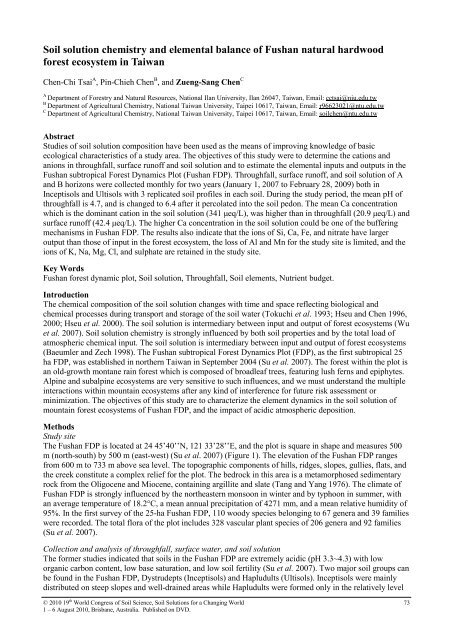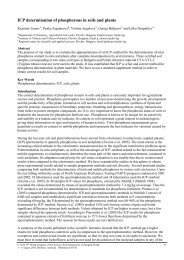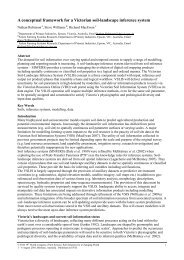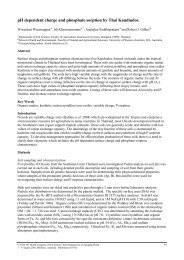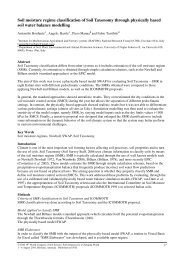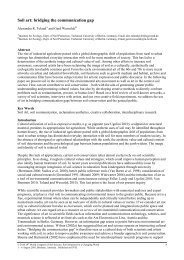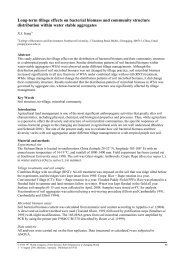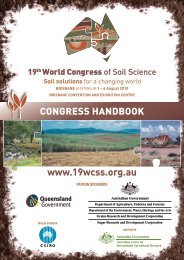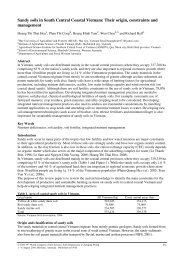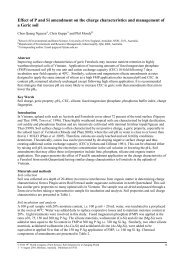Soil solution chemistry and elemental balance of Fushan natural ...
Soil solution chemistry and elemental balance of Fushan natural ...
Soil solution chemistry and elemental balance of Fushan natural ...
Create successful ePaper yourself
Turn your PDF publications into a flip-book with our unique Google optimized e-Paper software.
<strong>Soil</strong> <strong>solution</strong> <strong>chemistry</strong> <strong>and</strong> <strong>elemental</strong> <strong>balance</strong> <strong>of</strong> <strong>Fushan</strong> <strong>natural</strong> hardwood<br />
forest ecosystem in Taiwan<br />
Chen-Chi Tsai A , Pin-Chieh Chen B , <strong>and</strong> Zueng-Sang Chen C<br />
A Department <strong>of</strong> Forestry <strong>and</strong> Natural Resources, National Ilan University, Ilan 26047, Taiwan, Email: cctsai@niu.edu.tw<br />
B Department <strong>of</strong> Agricultural Chemistry, National Taiwan University, Taipei 10617, Taiwan, Email: r96623021@ntu.edu.tw<br />
C Department <strong>of</strong> Agricultural Chemistry, National Taiwan University, Taipei 10617, Taiwan, Email: soilchen@ntu.edu.tw<br />
Abstract<br />
Studies <strong>of</strong> soil <strong>solution</strong> composition have been used as the means <strong>of</strong> improving knowledge <strong>of</strong> basic<br />
ecological characteristics <strong>of</strong> a study area. The objectives <strong>of</strong> this study were to determine the cations <strong>and</strong><br />
anions in throughfall, surface run<strong>of</strong>f <strong>and</strong> soil <strong>solution</strong> <strong>and</strong> to estimate the <strong>elemental</strong> inputs <strong>and</strong> outputs in the<br />
<strong>Fushan</strong> subtropical Forest Dynamics Plot (<strong>Fushan</strong> FDP). Throughfall, surface run<strong>of</strong>f, <strong>and</strong> soil <strong>solution</strong> <strong>of</strong> A<br />
<strong>and</strong> B horizons were collected monthly for two years (January 1, 2007 to February 28, 2009) both in<br />
Inceptisols <strong>and</strong> Ultisols with 3 replicated soil pr<strong>of</strong>iles in each soil. During the study period, the mean pH <strong>of</strong><br />
throughfall is 4.7, <strong>and</strong> is changed to 6.4 after it percolated into the soil pedon. The mean Ca concentration<br />
which is the dominant cation in the soil <strong>solution</strong> (341 µeq/L), was higher than in throughfall (20.9 µeq/L) <strong>and</strong><br />
surface run<strong>of</strong>f (42.4 µeq/L). The higher Ca concentration in the soil <strong>solution</strong> could be one <strong>of</strong> the buffering<br />
mechanisms in <strong>Fushan</strong> FDP. The results also indicate that the ions <strong>of</strong> Si, Ca, Fe, <strong>and</strong> nitrate have larger<br />
output than those <strong>of</strong> input in the forest ecosystem, the loss <strong>of</strong> Al <strong>and</strong> Mn for the study site is limited, <strong>and</strong> the<br />
ions <strong>of</strong> K, Na, Mg, Cl, <strong>and</strong> sulphate are retained in the study site.<br />
Key Words<br />
<strong>Fushan</strong> forest dynamic plot, <strong>Soil</strong> <strong>solution</strong>, Throughfall, <strong>Soil</strong> elements, Nutrient budget.<br />
Introduction<br />
The chemical composition <strong>of</strong> the soil <strong>solution</strong> changes with time <strong>and</strong> space reflecting biological <strong>and</strong><br />
chemical processes during transport <strong>and</strong> storage <strong>of</strong> the soil water (Tokuchi et al. 1993; Hseu <strong>and</strong> Chen 1996,<br />
2000; Hseu et al. 2000). The soil <strong>solution</strong> is intermediary between input <strong>and</strong> output <strong>of</strong> forest ecosystems (Wu<br />
et al. 2007). <strong>Soil</strong> <strong>solution</strong> <strong>chemistry</strong> is strongly influenced by both soil properties <strong>and</strong> by the total load <strong>of</strong><br />
atmospheric chemical input. The soil <strong>solution</strong> is intermediary between input <strong>and</strong> output <strong>of</strong> forest ecosystems<br />
(Baeumler <strong>and</strong> Zech 1998). The <strong>Fushan</strong> subtropical Forest Dynamics Plot (FDP), as the first subtropical 25<br />
ha FDP, was established in northern Taiwan in September 2004 (Su et al. 2007). The forest within the plot is<br />
an old-growth montane rain forest which is composed <strong>of</strong> broadleaf trees, featuring lush ferns <strong>and</strong> epiphytes.<br />
Alpine <strong>and</strong> subalpine ecosystems are very sensitive to such influences, <strong>and</strong> we must underst<strong>and</strong> the multiple<br />
interactions within mountain ecosystems after any kind <strong>of</strong> interference for future risk assessment or<br />
minimization. The objectives <strong>of</strong> this study are to characterize the element dynamics in the soil <strong>solution</strong> <strong>of</strong><br />
mountain forest ecosystems <strong>of</strong> <strong>Fushan</strong> FDP, <strong>and</strong> the impact <strong>of</strong> acidic atmospheric deposition.<br />
Methods<br />
Study site<br />
The <strong>Fushan</strong> FDP is located at 24 45’40’’N, 121 33’28’’E, <strong>and</strong> the plot is square in shape <strong>and</strong> measures 500<br />
m (north-south) by 500 m (east-west) (Su et al. 2007) (Figure 1). The elevation <strong>of</strong> the <strong>Fushan</strong> FDP ranges<br />
from 600 m to 733 m above sea level. The topographic components <strong>of</strong> hills, ridges, slopes, gullies, flats, <strong>and</strong><br />
the creek constitute a complex relief for the plot. The bedrock in this area is a metamorphosed sedimentary<br />
rock from the Oligocene <strong>and</strong> Miocene, containing argillite <strong>and</strong> slate (Tang <strong>and</strong> Yang 1976). The climate <strong>of</strong><br />
<strong>Fushan</strong> FDP is strongly influenced by the northeastern monsoon in winter <strong>and</strong> by typhoon in summer, with<br />
an average temperature <strong>of</strong> 18.2°C, a mean annual precipitation <strong>of</strong> 4271 mm, <strong>and</strong> a mean relative humidity <strong>of</strong><br />
95%. In the first survey <strong>of</strong> the 25-ha <strong>Fushan</strong> FDP, 110 woody species belonging to 67 genera <strong>and</strong> 39 families<br />
were recorded. The total flora <strong>of</strong> the plot includes 328 vascular plant species <strong>of</strong> 206 genera <strong>and</strong> 92 families<br />
(Su et al. 2007).<br />
Collection <strong>and</strong> analysis <strong>of</strong> throughfall, surface water, <strong>and</strong> soil <strong>solution</strong><br />
The former studies indicated that soils in the <strong>Fushan</strong> FDP are extremely acidic (pH 3.3~4.3) with low<br />
organic carbon content, low base saturation, <strong>and</strong> low soil fertility (Su et al. 2007). Two major soil groups can<br />
be found in the <strong>Fushan</strong> FDP, Dystrudepts (Inceptisols) <strong>and</strong> Hapludults (Ultisols). Inceptisols were mainly<br />
distributed on steep slopes <strong>and</strong> well-drained areas while Hapludults were formed only in the relatively level<br />
© 2010 19 th World Congress <strong>of</strong> <strong>Soil</strong> Science, <strong>Soil</strong> Solutions for a Changing World<br />
1 – 6 August 2010, Brisbane, Australia. Published on DVD.<br />
73
portions <strong>of</strong> the plot. In this study, two sites each have three separate soil pr<strong>of</strong>iles are selected to underst<strong>and</strong><br />
the spatial variability, one is located on steep slope with Inceptisols, <strong>and</strong> the other is located at gentle slope<br />
with Ultisols (Figure 1). Throughfall, surface water, <strong>and</strong> soil <strong>solution</strong> <strong>of</strong> A (about 10 cm depth) <strong>and</strong> lowest<br />
layer <strong>of</strong> B horizon (about 60-100 cm depth) in each pr<strong>of</strong>ile were collected monthly. The study period ranged<br />
from January 2008 to February 2009 (14 months). Throughfall, surface water, <strong>and</strong> soil <strong>solution</strong> <strong>of</strong> A <strong>and</strong> B<br />
horizons were filtered by Whatman No.42 filter paper, <strong>and</strong> the analyses <strong>of</strong> items, cations <strong>and</strong> anions are<br />
listed as: pH, EC, DOC (Total Organic Carbon Analyser, Aurora Model 1030W), Ca, Mg, K, Na, Fe, Al,<br />
Mn, Si (ICP-AES, Perkin-Elmer 2100 DV), <strong>and</strong> NO3, PO4, SO4 <strong>and</strong> Cl ions (Metrohm, 792 Basic IC).<br />
Figure 1. Location <strong>and</strong> the contour map <strong>of</strong> the <strong>Fushan</strong> FDP drawn with 5-m intervals in elevation. The axis<br />
labels denote the horizontal distance (m) from the southweastern corner <strong>of</strong> the plot. The blue line indicates the<br />
creek (Su et al. 2007). Sampling location <strong>of</strong> soil <strong>solution</strong>s are indicated by triangles for pr<strong>of</strong>iles <strong>of</strong> Inceptisols (I1,<br />
I2, <strong>and</strong> I3) <strong>and</strong> indicated by circles for pr<strong>of</strong>iles <strong>of</strong> Ultisols (U1, U2, <strong>and</strong> U3).<br />
Results<br />
Charge <strong>balance</strong><br />
The volume-weighted equivalent mean the values <strong>of</strong> element concentration in throughfall, surface run<strong>of</strong>f,<br />
<strong>and</strong> soil <strong>solution</strong> <strong>of</strong> A <strong>and</strong> B horizons were showed (Figure 2). In general, total ion concentration <strong>of</strong> soil<br />
<strong>solution</strong> increased from throughfall to A horizon, <strong>and</strong> decreased from A to B horizon. The concentration <strong>of</strong><br />
potassium ion (K) was in decreasing order: surface run<strong>of</strong>f > throughfall > soil <strong>solution</strong>. Berg <strong>and</strong> Staaf<br />
(1987) suggested that K ion is the most mobile cation, <strong>and</strong> it could be fast eluviated in the initial stage <strong>of</strong><br />
litterfall decomposition. Highest K concentration in the surface run<strong>of</strong>f can be attributed to the decomposition<br />
<strong>of</strong> litterfall at soil surface. The rate <strong>of</strong> K cycling was fast, <strong>and</strong> K ion <strong>of</strong> soil <strong>solution</strong> was easily absorbed <strong>and</strong><br />
reused by plant roots resulting in lower concentration in soil <strong>solution</strong> (Sposito 1984; Grimaldi et al. 2004).<br />
The concentration <strong>of</strong> Cl - <strong>and</strong> Na + ion are both higher in throughfall, surface run<strong>of</strong>f <strong>and</strong> soil <strong>solution</strong>. The<br />
mean equivalent concentration <strong>of</strong> soil <strong>solution</strong> ranged from 44 to 60 µeq Cl/L <strong>and</strong> 82 to 120 µeq Na/L.<br />
Higher content <strong>of</strong> Cl <strong>and</strong> Na in soil <strong>solution</strong> suggested that sea salt significantly affect the soil <strong>solution</strong><br />
<strong>chemistry</strong> in <strong>Fushan</strong> FDP. M<strong>of</strong>fat et al. (2002) also indicated that sea salt events are important at sites close<br />
to the coast, <strong>and</strong> influence <strong>chemistry</strong> for short periods. Calcium is the dominant cation in soil <strong>solution</strong>s <strong>of</strong> A<br />
<strong>and</strong> B horizons; hence the response to acidic anion or proton input would be through Ca mobilization in<br />
<strong>Fushan</strong> forest. Comparisons between Inceptisols <strong>and</strong> Ultisols showed that obviously lower content <strong>of</strong> cations<br />
<strong>and</strong> anions in B horizon in Ultisols, which suggest that the strong leaching effects occur.<br />
Nutrient budget estimation<br />
The amount <strong>of</strong> input was estimated from the element concentration <strong>and</strong> collection the quantity <strong>of</strong> throughfall,<br />
<strong>and</strong> the amount <strong>of</strong> output was evaluated including soil surface run<strong>of</strong>f <strong>and</strong> soil <strong>solution</strong> collected in the lowest<br />
layer <strong>of</strong> B horizon. Elemental inputs <strong>of</strong> K, Na, Mg, Cl, <strong>and</strong> SO4 are obviously higher in the Ultisols area than<br />
those <strong>of</strong> the Inceptisols area (Table 1). The Ultisols are located at the northeastern side <strong>of</strong> the <strong>Fushan</strong> FDP<br />
receive more rainfall during the monsoon season in winter. In contrast, Inceptisols are located at the<br />
southwestern side <strong>and</strong> cannot h<strong>and</strong>le as much rainfall. Robson et al. (1994) suggested that spatial variation<br />
greatly influence the chemical composition <strong>of</strong> throughfall, <strong>and</strong> the variations change with the characteristics<br />
<strong>of</strong> study area, such as st<strong>and</strong> <strong>and</strong> l<strong>and</strong>scape position.<br />
In the Inceptisols area, the budget <strong>of</strong> Si, Ca, <strong>and</strong> NO3 has showed net loss, but K, Na, Cl, <strong>and</strong> SO4 ions are<br />
net gain in soil. The other elements, including Mg, Fe, Al, <strong>and</strong> Mn, are almost <strong>balance</strong>d in soil. Only Si <strong>and</strong><br />
© 2010 19 th World Congress <strong>of</strong> <strong>Soil</strong> Science, <strong>Soil</strong> Solutions for a Changing World<br />
1 – 6 August 2010, Brisbane, Australia. Published on DVD.<br />
74
Ca have showed net loss, K, Na, Mg, Cl <strong>and</strong> SO4 are net gain, <strong>and</strong> Fe, Al, Mn, <strong>and</strong> NO3 are almost <strong>balance</strong>d<br />
in soil system <strong>of</strong> Ultisols. The introduction <strong>of</strong> strong mobile acid anion (SO4 2- ) into these soil systems may<br />
enhance soil acidification via leaching <strong>of</strong> base cations from the exchange complex. Liu et al. (2008)<br />
investigated the soil <strong>solution</strong>s in three different horizons located on the upper slope, middle slope, <strong>and</strong> lower<br />
slope <strong>of</strong> a <strong>natural</strong> hardwood in <strong>Fushan</strong> forest from 2001 to 2004. Liu et al. (2008) also indicated that except<br />
for H + when precipitation passed through the canopy, total ion concentration was increased, <strong>and</strong><br />
concentrations <strong>of</strong> Na, K, Ca, Mg, F, Cl, PO4 3- , SO4 2- , <strong>and</strong> HCO3 - in the throughfall generally exceeded the<br />
soil <strong>solution</strong> at the upper <strong>and</strong> middle slopes, whereas at the lower slope, Na, Ca, Mg, F, <strong>and</strong> Cl<br />
concentrations were highest at the 15 cm depth. This study has similar results to another study in <strong>Fushan</strong><br />
FDP (Liu et al. 2008).<br />
(a) Inceptisols (b) Ultisols<br />
Anion, µeq/L<br />
Cation, µeq/L<br />
Anion, µeq/L<br />
Throughfall<br />
Run<strong>of</strong>f<br />
A Horizon<br />
Inceptisols<br />
Figure B Horizon 2. Volume-weighted equivalent means <strong>of</strong> cations Charge deficit <strong>and</strong> B anions Horizon <strong>of</strong> the throughfall, run<strong>of</strong>f <strong>and</strong> soil <strong>solution</strong> in<br />
A <strong>and</strong> B horizon <strong>of</strong> Inceptisols (a) <strong>and</strong> Ultisols (b).<br />
Table 1. Estimated element budget (kg/ha/yr) in Inceptisol <strong>and</strong> Ultisol sites.<br />
-600 -400 -200 0 200 400 600<br />
ions Inputs Outputs Inputs - Outputs<br />
Inceptisols<br />
K 60.6 16.6 44.0<br />
Na 54.6 20.9 33.8<br />
Ca 22.4 81.8 -59.3<br />
Mg 12.6 11.2 1.44<br />
Fe 1.81 1.88 -0.07<br />
Al 2.86 2.38 0.48<br />
Mn 0.58 0.19 0.39<br />
Si 4.84 7.51 -2.68<br />
Cl 160 56.0 104<br />
NO3 52.0 101 -49.2<br />
SO4 99.3 49.5<br />
Ultisols<br />
49.8<br />
K 105 17.7 87.5<br />
Na 62.6 19.6 43.0<br />
Ca 24.4 51.3 -26.9<br />
Mg 26.0 8.02 18.0<br />
Fe 1.41 2.68 -1.27<br />
Al 2.31 2.44 -0.13<br />
Mn 0.69 0.13 0.6<br />
Si 4.35 7.29 -2.94<br />
Cl 231 62.2 169<br />
NO3 40.6 40.5 0.03<br />
SO4 127 54.6 72.2<br />
Notes: The elements budget was calculated from the data collected from January 2008 to February 2009.<br />
© 2010 19 th World Congress <strong>of</strong> <strong>Soil</strong> Science, <strong>Soil</strong> Solutions for a Changing World<br />
1 – 6 August 2010, Brisbane, Australia. Published on DVD.<br />
K<br />
Na<br />
Ca<br />
Mg<br />
Fe<br />
Al<br />
Mn<br />
Cl<br />
NO 3<br />
SO 4<br />
Throughfall<br />
Run<strong>of</strong>f<br />
A Horizon<br />
Ultisols<br />
Cation, µeq/L<br />
-600 -400 -200 0 200 400 600<br />
K<br />
Na<br />
Ca<br />
Mg<br />
Fe<br />
Al<br />
Mn<br />
Cl<br />
NO 3<br />
SO 4<br />
Charge deficit<br />
75
Uncertainty <strong>of</strong> nutrient budget estimation<br />
In this study, the estimation <strong>of</strong> nutrient budget in the <strong>Fushan</strong> FDP was established <strong>and</strong> calculated based on<br />
evaluated database. For this reason, errors or uncertainties could occur, including (1) the limitation <strong>of</strong><br />
sampling number <strong>and</strong> replication; (2) the difference <strong>of</strong> spatial distribution <strong>of</strong> soil properties <strong>and</strong> tree species;<br />
(3) the different nutrient concentration <strong>of</strong> tree species; (4) the estimation method <strong>of</strong> forest biomass <strong>and</strong><br />
litterfall amount; (5) the lateral mobile <strong>of</strong> soil <strong>solution</strong> in soil layer; (6) the frequently effect <strong>and</strong> disturbance<br />
by typhoon; (7) the amount <strong>of</strong> increase from dry precipitation (input) <strong>and</strong> loss from evaporation (output); <strong>and</strong><br />
(8) the overestimation <strong>of</strong> nutrient output based on the amount collected from the soil <strong>solution</strong> in B horizon.<br />
Conclusion<br />
The mean pH value <strong>of</strong> rain water <strong>and</strong> throughfall in the <strong>Fushan</strong> FDP during the study period is 4.6 <strong>and</strong> 4.7,<br />
respectively. The pH <strong>of</strong> soil <strong>solution</strong> has raised 1.5 pH units (pH 6.4 in average) after the throughfall<br />
percolation into the soils. Calcium is the dominant basic cation in soil <strong>solution</strong>, with a mean concentration <strong>of</strong><br />
341 µeq/L <strong>and</strong> is much higher than in throughfall <strong>and</strong> surface run<strong>of</strong>f. The response to acidic anion or proton<br />
input would be through Ca mobilization in <strong>Fushan</strong> forest. The budget <strong>of</strong> Si, Ca, <strong>and</strong> NO3 in the Inceptisol<br />
area <strong>and</strong> Si <strong>and</strong> Ca in the Ultisol area show a net loss. The input amount <strong>of</strong> K, Na, Cl <strong>and</strong> SO4 are much<br />
higher than those <strong>of</strong> output, <strong>and</strong> suggest the net gain in soils. Iron, Al <strong>and</strong> Mn have similar input <strong>and</strong> output<br />
contents. In this study, the estimation <strong>and</strong> evaluation <strong>of</strong> nutrient budget based on throughfall, surface run<strong>of</strong>f,<br />
<strong>and</strong> soil <strong>solution</strong> (located in A <strong>and</strong> B horizon) seem that it is not sufficient <strong>and</strong> has many uncertainties<br />
factors. The long-term monitoring <strong>of</strong> precipitation inputs <strong>of</strong> nitrate <strong>and</strong> sulfate in the <strong>Fushan</strong> forest is<br />
important.<br />
References<br />
Baeumler R, Zech W (1998) <strong>Soil</strong> <strong>solution</strong> <strong>chemistry</strong> <strong>and</strong> impact <strong>of</strong> forest thinning in mountain forests in the<br />
Bavarian Alps. Forest Ecology <strong>and</strong> Management 108, 231-238.<br />
Berg B, Staaf H (1987) Release <strong>of</strong> nutrients from decomposing white birch leaves <strong>and</strong> Scots pine needle<br />
litter. Pedobiologia 30, 55-63.<br />
Grimaldi C, Grimaldi M, Millet A, Bariac T, Boulegue J (2004) Behaviour <strong>of</strong> chemical solutes during a<br />
storm in a rainforested headwater catchment. Hydrological Processes 18, 93-106.<br />
Hseu ZY, Chen ZS (1996) Saturation, reduction, <strong>and</strong> redox morphology <strong>of</strong> seasonally flooded Alfisols in<br />
Taiwan. <strong>Soil</strong> Science Society <strong>of</strong> America Journal 60, 941-949.<br />
Hseu ZY, Chen ZS (2001) Quantifying soil hydromorphology <strong>of</strong> a rice-growing Ultisol toposequence in<br />
Taiwan. <strong>Soil</strong> Science Society <strong>of</strong> America Journal 65, 270-278.<br />
Hseu ZY, Chen ZS, Leu IY (2000) <strong>Soil</strong> <strong>solution</strong> composition, water tables <strong>and</strong> redox potentials <strong>of</strong> anthraquic<br />
Ultisols in a toposequence. <strong>Soil</strong> Science 165, 869-880.<br />
Liu CP, Lu SY, Wang CH, Hwang LS (2008) <strong>Soil</strong> <strong>solution</strong> <strong>chemistry</strong> on the three slopes <strong>of</strong> a <strong>natural</strong><br />
hardwood st<strong>and</strong> in the subtropics <strong>of</strong> the <strong>Fushan</strong> forest. <strong>Soil</strong> Science 173, 845-856.<br />
M<strong>of</strong>fat AJ, Kvaalen H, Solberg S, Clarke N (2002) Temporal trends in throughfall <strong>and</strong> soil water <strong>chemistry</strong><br />
at three Norwegian forests, 1986-1997. Forest Ecology <strong>and</strong> Management 168, 15-28.<br />
Robson AJ, Neal C, Ryl<strong>and</strong> GP, Harrow M (1994) Spatial variations in throughfall <strong>chemistry</strong> at the small<br />
plot scale. Journal <strong>of</strong> Hydrology 158, 107-122.<br />
Sposito G (1984) The future <strong>of</strong> an illusion-ion activities in soil <strong>solution</strong>s. <strong>Soil</strong> Science Society <strong>of</strong> American<br />
Journal 48, 531-536.<br />
Su SH, Chang-Yang CH, Lu CL, Tsui CC, Lin TT, Lin CL, Chiou WL, Kuan LH, Chen ZS, Hsieh CF<br />
(2007) <strong>Fushan</strong> subtropical forest dynamics plot: tree species characteristics <strong>and</strong> distribution patterns.<br />
Taiwan Forest Research Institute (TFRI) Extension Series No. 177. 272 pp. (TFRI: Taipei, Taiwan).<br />
Tang CH, Yang CY (1976) Mid-tertiary stratigraphic break in the northeast Hsuehshan Range <strong>of</strong> Taiwan.<br />
Petroleum Geology <strong>of</strong> Taiwan 13, 139-147.<br />
Tokuchi N, Takeda H, Iwatsubo G (1993) Vertical changes in soil <strong>solution</strong> <strong>chemistry</strong> in soil pr<strong>of</strong>iles under<br />
coniferous forest. Geoderma 59, 57-73.<br />
Wu CC, Tsui CC, Hsieh CF, Asio VB, <strong>and</strong> Chen ZS (2007) Mineral nutrient status <strong>of</strong> tree species in relation<br />
to environmental factors in the subtropical rain forest <strong>of</strong> Taiwan. Forest Ecology <strong>and</strong> Management<br />
239, 92-101.<br />
© 2010 19 th World Congress <strong>of</strong> <strong>Soil</strong> Science, <strong>Soil</strong> Solutions for a Changing World<br />
1 – 6 August 2010, Brisbane, Australia. Published on DVD.<br />
76


